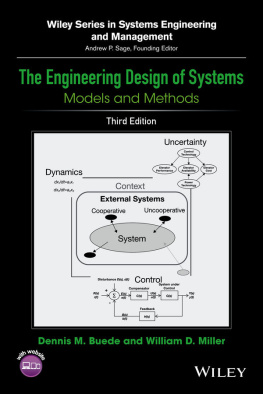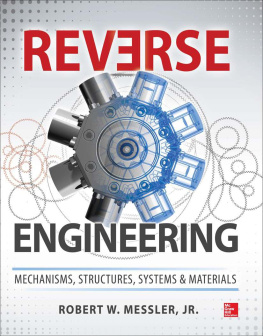Dennis M. Buede - The Engineering Design of Systems: Models and Methods
Here you can read online Dennis M. Buede - The Engineering Design of Systems: Models and Methods full text of the book (entire story) in english for free. Download pdf and epub, get meaning, cover and reviews about this ebook. year: 2016, publisher: John Wiley & Sons, genre: Science. Description of the work, (preface) as well as reviews are available. Best literature library LitArk.com created for fans of good reading and offers a wide selection of genres:
Romance novel
Science fiction
Adventure
Detective
Science
History
Home and family
Prose
Art
Politics
Computer
Non-fiction
Religion
Business
Children
Humor
Choose a favorite category and find really read worthwhile books. Enjoy immersion in the world of imagination, feel the emotions of the characters or learn something new for yourself, make an fascinating discovery.
- Book:The Engineering Design of Systems: Models and Methods
- Author:
- Publisher:John Wiley & Sons
- Genre:
- Year:2016
- Rating:4 / 5
- Favourites:Add to favourites
- Your mark:
- 80
- 1
- 2
- 3
- 4
- 5
The Engineering Design of Systems: Models and Methods: summary, description and annotation
We offer to read an annotation, description, summary or preface (depends on what the author of the book "The Engineering Design of Systems: Models and Methods" wrote himself). If you haven't found the necessary information about the book — write in the comments, we will try to find it.
The Engineering Design of Systems: Models and Methods — read online for free the complete book (whole text) full work
Below is the text of the book, divided by pages. System saving the place of the last page read, allows you to conveniently read the book "The Engineering Design of Systems: Models and Methods" online for free, without having to search again every time where you left off. Put a bookmark, and you can go to the page where you finished reading at any time.
Font size:
Interval:
Bookmark:
Andrew P. Sage, Founding Editor
A complete list of the titles in this series appears at the end of this volume.
Third Edition
Dennis M. Buede
Innovative Decisions, Inc.
Reston, Virginia
William D. Miller
Innovative Decisions, Inc.
Berkeley Heights, New Jersey

Copyright 2016 by John Wiley & Sons, Inc. All rights reserved
Published by John Wiley & Sons, Inc., Hoboken, New Jersey
Published simultaneously in Canada
No part of this publication may be reproduced, stored in a retrieval system, or transmitted in any form or by any means, electronic, mechanical, photocopying, recording, scanning, or otherwise, except as permitted under Section 107 or 108 of the 1976 United States Copyright Act, without either the prior written permission of the Publisher, or authorization through payment of the appropriate per-copy fee to the Copyright Clearance Center, Inc., 222 Rosewood Drive, Danvers, MA 01923, (978) 750-8400, fax (978) 750-4470, or on the web at www.copyright.com. Requests to the Publisher for permission should be addressed to the Permissions Department, John Wiley & Sons, Inc., 111 River Street, Hoboken, NJ 07030, (201) 748-6011, fax (201) 748-6008, or online at http://www.wiley.com/go/permission.
Limit of Liability/Disclaimer of Warranty: While the publisher and authors have used their best efforts in preparing this book, they make no representations or warranties with respect to the accuracy or completeness of the contents of this book and specifically disclaim any implied warranties of merchantability or fitness for a particular purpose. No warranty may be created or extended by sales representatives or written sales materials. The advice and strategies contained herein may not be suitable for your situation. You should consult with a professional where appropriate. Neither the publisher nor authors shall be liable for any loss of profit or any other commercial damages, including but not limited to special, incidental, consequential, or other damages.
For general information on our other products and services or for technical support, please contact our Customer Care Department within the United States at (800) 762-2974, outside the United States at (317) 572-3993 or fax (317) 572-4002.
Wiley also publishes its books in a variety of electronic formats. Some content that appears in print may not be available in electronic formats. For more information about Wiley products, visit our web site at www.wiley.com.
Library of Congress Cataloging-in-Publication Data applied for.
ISBN: 9781119027904
Dennis: In memory of my Mother and Father
Bill: To John Lewis, Mal Buchner, Jake Schaefer,
and Les Kleinberg who inspired and
nurtured this nascent systems engineer
Preface
This book is meant to be a basic text for courses in the engineering design of systems at both the upper division undergraduate and beginning graduate levels. The book is the product of many years of consulting on numerous portions of the system development process, research into the use of systems engineering in industry, and 6 years developing a course on the engineering design of systems. During the development of this book, I found that many engineers did not understand systems engineering. Even those who do may not have a good perspective on a complete and unified process for engineering a system. The desire to suppress the number of decisions being made during design is quite strong in most engineers. While engineers have learned modeling throughout their academic life, and most have developed models during the practice of engineering, very few engineers working on systems are knowledgeable of the modeling techniques required in systems engineering. In addition, most engineers are not aware of methods for using models during the systems engineering process. As a result, I adopted the following themes in formulating this book:
- Defining the design problem in systems engineering is one of several keys to success and can be approached systematically using engineering techniques.
- The design problem in systems engineering is defined in terms of requirements. These requirements evolve from a high-level set of mission and stakeholders' requirements to detailed sets of derived requirements.
- The design process will fail if the requirements are defined too narrowly, leaving little if any room for design decisions and raising the possibility that no feasible solution exists. The design problem should be well defined and decision rich.
- For the design problem to be well defined, the evolving sets of requirements must be complete (none missing), consistent (no contradictions), correct (valid for an acceptable solution), and attainable (an acceptable solution exists). While it is not possible at this time to state requirements mathematically and prove these properties, it is possible to develop mathematical and heuristic representations of the design problem to assist in evaluating the presence of these properties.
- These characteristics of the requirements will not be achieved if scenarios defining how the system will be used are not elaborated in detail, the interactions among the system and other systems are not defined, and the stakeholders' objectives are not understood. Each of these requires a different kind of modeling to be successful.
- The design problem is not likely to be well defined if the requirements do not address every relevant phase of the system's life cycle.
- The design problem is not likely to be well defined if the requirements do not contain stakeholder preferences for comparing feasible designs against each other.
- The keys to understanding many of the modeling techniques for developing requirements, defining architectures, and deriving requirements are found in discrete mathematics: set theory, relations and functions, and graph theory.
- Integration requires a well-defined design, including a design of the qualification process for verification, validation, and acceptance. A systematic process of design provides all of the necessary inputs for defining the qualification process.
- Early validation of the evolution of the definition of the design problem needs to be pursued vigorously to ensure that the definition of the design problem does not change as the problem is defined in greater detail.
- Qualification of the system is the key issue in integration. Qualification includes verification and validation of both the requirements and the system design, followed by the stakeholders' acceptance. There are many methods for qualifying the system; these methods must be chosen judiciously.
- Successful qualification also requires that decisions about what should be tested be made in a systematic way that balances the two conflicting objectives of not wasting resources and obtaining stakeholder acceptance.
The major changes made in the third edition is the addition of three new chapters: has been rewritten to address the integration of the new chapters and updates have been made throughout the original chapters.
The book is divided into three major parts: (1) Introduction, Overview and Basic Knowledge, (2) Design and Integration Topics, and (3) Supplemental Topics. The first part provides an introduction to the issues associated with the engineering of a system. Next, an overview of the engineering process is provided so that readers will have a context for the more detailed material. Finally, basic knowledge needed for the core material is presented. Homework problems are provided at the end of each chapter.
Font size:
Interval:
Bookmark:
Similar books «The Engineering Design of Systems: Models and Methods»
Look at similar books to The Engineering Design of Systems: Models and Methods. We have selected literature similar in name and meaning in the hope of providing readers with more options to find new, interesting, not yet read works.
Discussion, reviews of the book The Engineering Design of Systems: Models and Methods and just readers' own opinions. Leave your comments, write what you think about the work, its meaning or the main characters. Specify what exactly you liked and what you didn't like, and why you think so.







